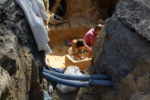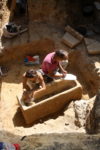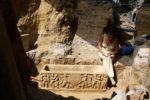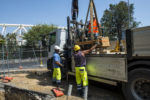 Workers installing new pipelines near Rome’s Olympic Stadium this summer uncovered two ancient Roman children’s’ sarcophagi. The ENEA utility company stumbled on the artifacts while digging in the Monte Mario neighborhood just behind the north curve of the stadium. They stopped the work and reported the find to the Special Superintendency for the Colosseum and the Archaeological Area of Central Rome which sent an archaeological team to excavate the site.
Workers installing new pipelines near Rome’s Olympic Stadium this summer uncovered two ancient Roman children’s’ sarcophagi. The ENEA utility company stumbled on the artifacts while digging in the Monte Mario neighborhood just behind the north curve of the stadium. They stopped the work and reported the find to the Special Superintendency for the Colosseum and the Archaeological Area of Central Rome which sent an archaeological team to excavate the site.
 The marble sarcophagi were found about eight feet below street level. One of them is rough hewn, the chisel marks clearly visible on the interior and exterior, while the other is decorated with a bas relief on the exterior. The relief depicts a central pair of erotes (Cupid-like figures also known as putti or cherubs) holding aloft a circular medallion that is either too eroded or too soil-encrusted to identify the image it bears. It was likely an image of the deceased called a clipeus portrait, or perhaps a mythological reference. Two small figures recline underneath the medallion. On the right and left sides of
The marble sarcophagi were found about eight feet below street level. One of them is rough hewn, the chisel marks clearly visible on the interior and exterior, while the other is decorated with a bas relief on the exterior. The relief depicts a central pair of erotes (Cupid-like figures also known as putti or cherubs) holding aloft a circular medallion that is either too eroded or too soil-encrusted to identify the image it bears. It was likely an image of the deceased called a clipeus portrait, or perhaps a mythological reference. Two small figures recline underneath the medallion. On the right and left sides of  the central scene are pairs of embracing Cupids and Pyches. Individual erotes cap the ends of the panel. Both it and the other, plainer sarcophagus were expensive luxury items that only the wealthy could afford. The children buried in them must have been from well-to-do families.
the central scene are pairs of embracing Cupids and Pyches. Individual erotes cap the ends of the panel. Both it and the other, plainer sarcophagus were expensive luxury items that only the wealthy could afford. The children buried in them must have been from well-to-do families.
Erotes were common motifs in funerary reliefs, particularly for children because they’re basically babies with wings. They continued to be used into the Christian era, reinterpreted as angels bringing ![]() the souls of the dead to heaven. The Metropolitan Museum of Art has a sarcophagus with very similar iconography to the one found near the stadium, although the clipeus portrait identifies the deceased as a young man, not a child.
the souls of the dead to heaven. The Metropolitan Museum of Art has a sarcophagus with very similar iconography to the one found near the stadium, although the clipeus portrait identifies the deceased as a young man, not a child.
 Preliminary examination suggests the sarcophagi date to the 3rd or 4th century A.D. — the Met’s sarcophagus dates to the late 2nd, early 3rd century and the more refined carving is indicative of an earlier date than the cruder art on the newly discovered one. The dating can’t be asserted with confidence until the objects have been subjected to further testing. Concerned that the open excavation pit was too easily accessible to vandals and looters, archaeologists decided to remove the sarcophagi from the site as soon as they could. They have been transported to the laboratories of the Special Superintendency to be cleaned, studied and conserved. The first dating results and other research will be published next fall.
Preliminary examination suggests the sarcophagi date to the 3rd or 4th century A.D. — the Met’s sarcophagus dates to the late 2nd, early 3rd century and the more refined carving is indicative of an earlier date than the cruder art on the newly discovered one. The dating can’t be asserted with confidence until the objects have been subjected to further testing. Concerned that the open excavation pit was too easily accessible to vandals and looters, archaeologists decided to remove the sarcophagi from the site as soon as they could. They have been transported to the laboratories of the Special Superintendency to be cleaned, studied and conserved. The first dating results and other research will be published next fall.
Putti is ultimately the source for “puttana” and “puttanesca” in Italian and “putta/o” in Spanish. No doubt originally punning on the idea of cupids and erotes.
Those “Pyches” (an ‘s’ is missing) seem of a rather ‘winking’ nature, sarcophagus or ‘sarkophageo’ (=’to eat flesh’) is a Greek ‘loan word’ and once the interred human sarkis is ‘phaged’ away, some of them were reused.
Thus, the ‘Vandal’ might not necessarily be the one trying to steal the coffin, but the one once buried inside. Is there information about ‘context’, i.e. is there some form of “ancient burial ground” known, where now Rome’s “Olympic” Stadium seems to be ?
As far as I can tell, those winged infants were referred to as cupids (‘Cupido’, the god of love), wile ‘erotes’ (Greek origin of cupid), ‘putti’ and ‘cherubs’ (Hebrew?) are seemingly later attributions sourced from elsewhere.
—————————
PS: I read that a quiver was originally referred to as ‘cocker’ (cf. ‘Köcher’), and the one from the sarcophagus might explain why :no:
Welcome back to my computer screen. I thought I should treat you to this morning’s historical observation.
We found ourselves driving behind a white tradesman’s van. The white back doors were decorated by a clever representation in grey of a Roman plaque with the lettering “I, Claudius” and in smaller letters beneath “Hempstead”. I’ve goolagged him and here he is:-
https://www.yell.com/biz/claudius-hempstead-plumbing-and-heating-cambridge-3365358/
I thought I might ask him what he’d charge to knock me up an aqueduct.
The circular medallion is not eroded.
It is not soil-encrusted.
It is just plain, uncarved.
The carvers prepared the sarcophagus in advance, and they left a rough space for the portrait (sometimes a plain space, sometimes a bust with rough, unfinished face).
This was a common practice.
Later, when someone purchased the sarcophagus for a dead, they where supposed to sculpt the face of the dead (or whatever a symbol the buyer like to have).
Sometimes (quite often, actually) for various reasons (hurry to bury the dead body or lack of money, because sculpt the portrait has an extra cost, of course) the clypeus (round sculpted medallion bearing a portrait) remained unfinished.
Thanks, Tilius. I’m sure your explanation is correct. A similar situation applies to early English furniture. Central medallions were left blank to be carved with initials or whatever after it had been sold.
On a lighter note: I swear those Psyches on the Met sarcophagus are clockwork! (Note the keys on their backs.) 🙂
😆 I had the same impression about those ‘clockworked’ Met Psyches.
First, I was wondering if the wings were either just worn down, which seemed unlikely as particularly theirs are -very regularly- like that. Then, I had the idea that the ‘real thing’, i.e. made from another material or softer stone, was once mounted on there and the ‘circular medallions’ could have featured a similar solution.
——–
PS: Maybe, some Roman ‘sarkophagoi’ were individually customized: ‘You can have Psyche wings in gold, red and blue –plus– an individually carved medallion’